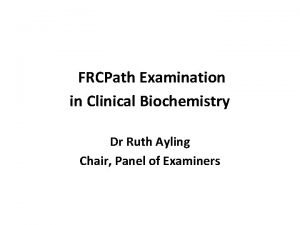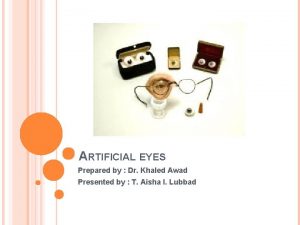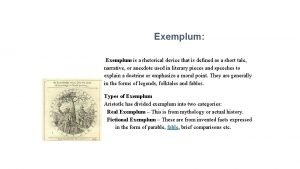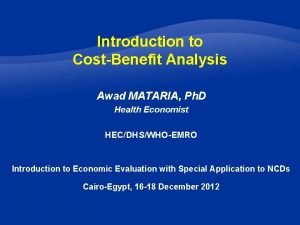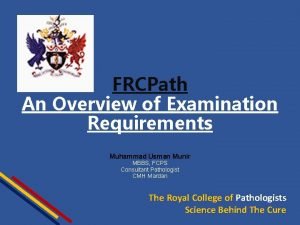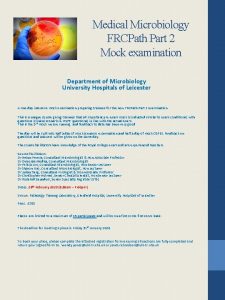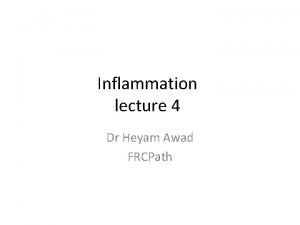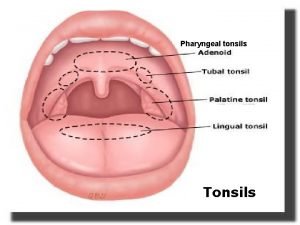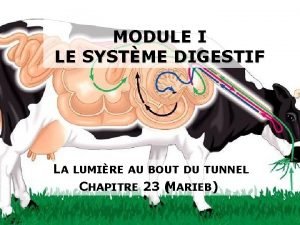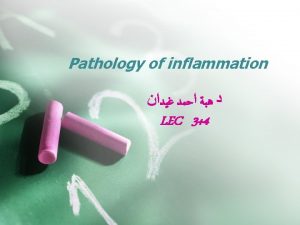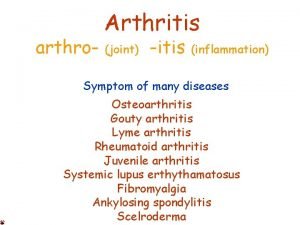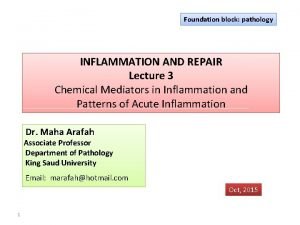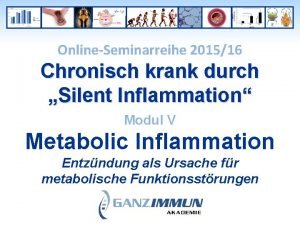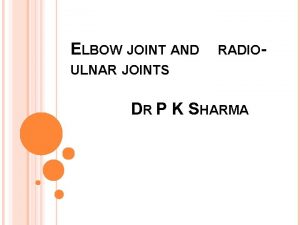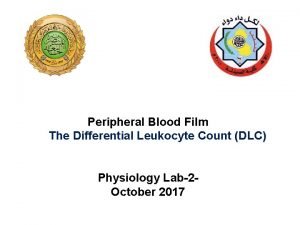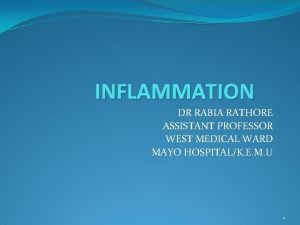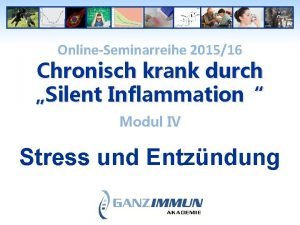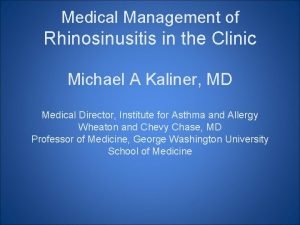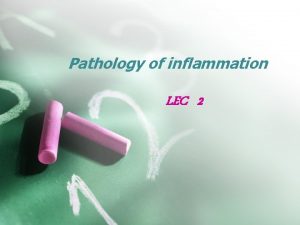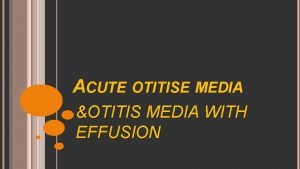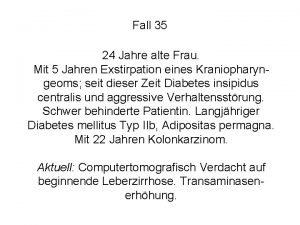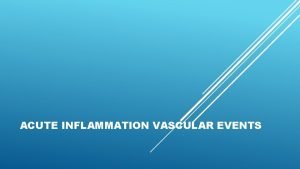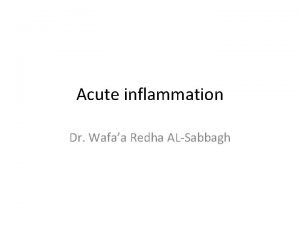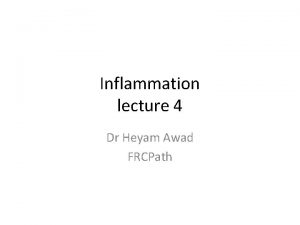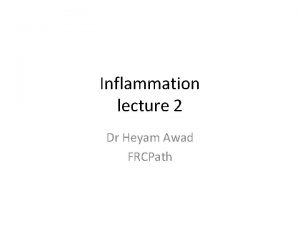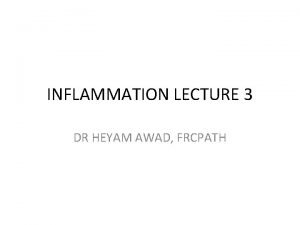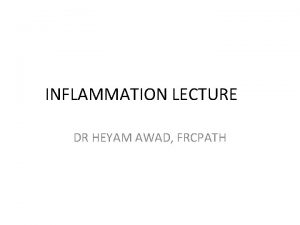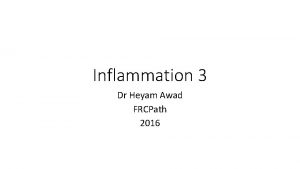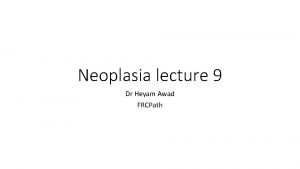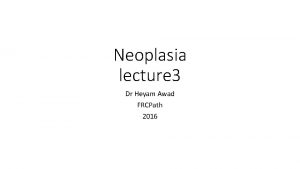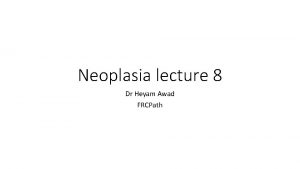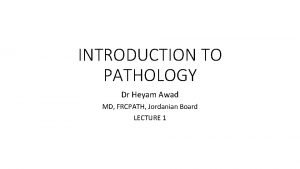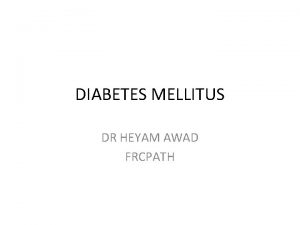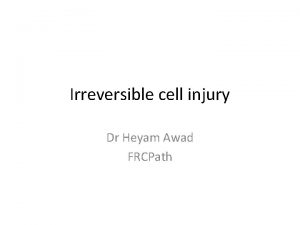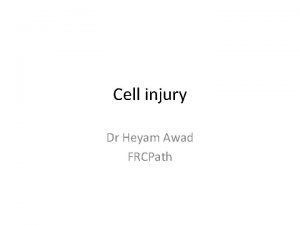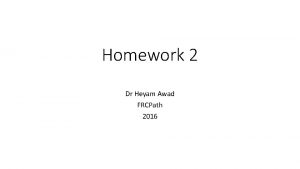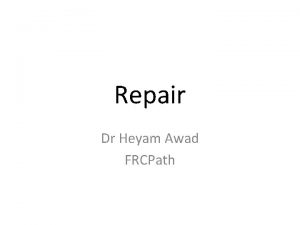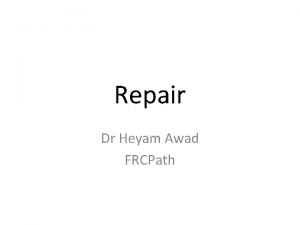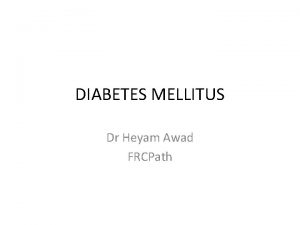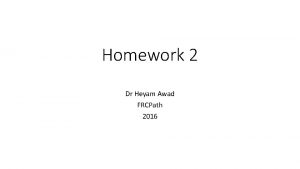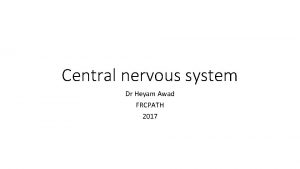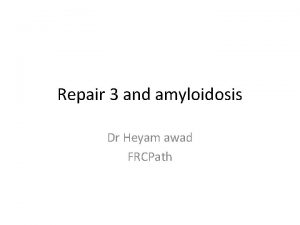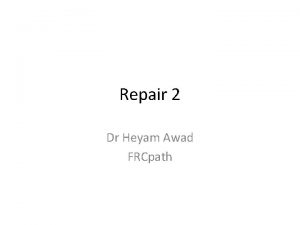Inflammation lecture 4 Dr Heyam Awad FRCPath Chemical


































- Slides: 34

Inflammation lecture 4 Dr Heyam Awad FRCPath

Chemical mediators • 1 - locally produced or secreted by cells at the site of inflammation. or • 2 - circulating in the plasma in an inactive form that need to be activated at the site of inflammation

• Preformed mediators are stored in cell granules… released quickly when needed • Other mediators need to be synthesized… need time to act • Preformed VS synthesized

Action of mediators • Act by binding to receptors. • One mediator… several actions. • One mediator… receptors on several cells.

Regulation of mediators' actions The actions of most mediators are tightly regulated by: • Quick decay (e. g. , arachidonic acid metabolites) • Enzymatic inactivation (e. g. , kininase inactivates bradykinin) • elimination (e. g. , antioxidants scavenge toxic oxygen metabolites), • inhibition (complement-inhibitory proteins)

The principal chemical mediators of inflammation

Vasoactive amines histamine and serotonin Histamine • causes vasodialtion, increased permeability. • Responsible for edema. • Preformed in mast cells, basophils and platelets. • Inactivated by histaminase.

serotonin • Stored in platelet granules • Vasoconstrictor, especially during clot formation. • neurotransmitter.

Platelet activating factor • Generated from membrane phospholipids by phospholipase A 2. • Neutrophils, monocytes, basophils, platelet, endothelial cells and other cells. • Potent broncho-constrictor. • Potent vasodilator. • Stimulates synthesis of other mediators.

Arachidonic acid metabolites

SOURCES OF AA

Arachidonic acid (AA) metabolites • AA … fatty acid present in cell membrane. • Phospholipase, during inflammation releases it from membrane to cytoplasm. • Two enzymes act upon it to form two families of mediators. • Metabolites: eicosanoids (20 carbon) fatty acids.


Membrane phospholipid Phospholipase A 2 Arachidonic acid cyclooxygenases (COX) PROSTAGLANDINS lipooxygenases LEUKOTRIENS ………. LK B 4, C 4, D 4, E 4 PG E 2 PG D 2 Prostacycli n. PG I 2 Thromboxane A 2 LIPOXINS…. LX A 4, LX B 4

Membrane phospholipid Phospholipase A 2 Arachidonic acid cyclooxygenases (COX) PROSTAGLANDINS lipooxygenases LEUKOTRIENS ………. LK B 4, C 4, D 4, E 4 PG E 2 PG D 2 Prostacycli n. PG I 2 Thromboxane A 2 LIPOXINS…. LX A 4, LX B 4

Membrane phospholipid Phospholipase A 2 Arachidonic acid cyclooxygenases (COX) PROSTAGLANDINS lipooxygenases LEUKOTRIENS ………. LK B 4, C 4, D 4, E 4 PG E 2 PG D 2 Prostacycli n. PG I 2 Thromboxane A 2 LIPOXINS…. LX A 4, LX B 4

Cyclooxygenase pathway Produces: prostaglandins. • PG E 2 • PG I 2(Prostacyclin) • PG D 2 • THROMBOXANE A 2

• PG E 2 and PG D 2 have similar effect: -vasodilatation. -edema. -pain. -interact with cytokines to cause fever.

Thromboxane A 2 prostacyclin Produced in platelets Produced in endothelial cells vasoconstrictor vasodilator Stimulate platelet aggregation Inhibit platelet aggregation

Lipooxygenase pathway • Produced leukotrienes and lipoxins.

Leukotrienes LT • LT B 4… CHEMOTACTIC AGENT. Produced mainly in neutrophils • LT C 4 • LT D 4 • LT E 4 C 4, D 4 AND E 4…. Cause bronchospasm and increased vascular permeability. These are produced mainly in mast cells.

Lipoxins (LX) • LX A 4 AND LX B 4 • Anti-inflammatory effects. • Inhibit neutrophil adhesion and chemotaxis.

Anti-inflammatory drugs affecting AA metabolites

STEROID EFFECT Membrane phospholipid Phospholipase A 2 ( inhibited by steroids) ALL PATHWAY BLOCKED Arachidonic acid cyclooxygenases (COX) PROSTAGLANDINS lipooxygenases LEUKOTRIENS ………. LK B 4, C 4, D 4, E 4 PG E 2 PG D 2 Prostacycli n. PG I 2 Thromboxane A 2 LIPOXINS…. LX A 4, LX B 4

Steroids cut the stem. . All the tree falls

ASPIRIN AND NSAIDS inhibit COX family PG inhibited… lipooxygenase pathway not affected Membrane phospholipid Phospholipase A 2 Arachidonic acid cyclooxygenases (COX) Aspirin and NSAIDS inhibit COX lipooxygenases ( PROSTAGLANDINS LEUKOTRIENS ………. LK B 4, C 4, D 4, E 4 PG E 2 PG D 2 Prostacycli n. PG I 2 Thromboxane A 2 LIPOXINS…. LX A 4, LX B 4

NSAIDS and Aspirin cut COX trunk only!!

Antiinflammatory drugs

COX family • COX is a family of several enzymes divided to two subfamilies COX 1 and COX 2. • COX 1 products are produced during inflammation but also in normal tissue where they protect the gastric mucosa and maintain fluid and electrolyte balance in the kidney. • COX 2 products. . Only in inflammation

• When patients are given NSAIDS. . COX 1 and COX 2 are inhibited. . That’s why patients develop gastric upset (gastritis and ulcers). • HOW to solve this? . . Cut only COX 2 trunk of the tree! • New drugs: COX 2 inhibitors. . So products of COX 2 inhibited whereas COX 1 (protective, good prostaglandins) are produced normally.

PROBLEM with COX 2 inhibitors • Althogh COX 2 inhibitors protect the stomach, they can cause another problem!!! • Thromboxane A 2 is a product of COX 1 family whereas prostacyclin is a product of COX 2…. So COX 2 inhibitors disturb the balance between these two. . resulting in increased risk of thrombi.


Principal Inflammatory Actions of Arachidonic Acid Metabolites (Eicosanoids) Action Eicosanoid Vasodilation PGI 2 (prostacyclin), PGE 1, PGE 2, PGD 2 Vasoconstriction Thromboxane A 2, Increased vascular permeability Leukotrienes C 4, D 4, E 4 Chemotaxis, leukocyte adhesion Leukotriene B 4

 Frcpath clinical biochemistry past papers
Frcpath clinical biochemistry past papers Khaled awad md
Khaled awad md Exemplum definition literature
Exemplum definition literature Awad mataria
Awad mataria Mydetas
Mydetas Frcpath part 1 microbiology
Frcpath part 1 microbiology Chemical mediators of inflammation
Chemical mediators of inflammation 01:640:244 lecture notes - lecture 15: plat, idah, farad
01:640:244 lecture notes - lecture 15: plat, idah, farad Modern chemistry chapter 7
Modern chemistry chapter 7 Chapter 7 review chemical formulas and chemical compounds
Chapter 7 review chemical formulas and chemical compounds Are kc and kp equal
Are kc and kp equal Section 2 classifying chemical reactions worksheet answers
Section 2 classifying chemical reactions worksheet answers Chemical reactions section 1 chemical changes
Chemical reactions section 1 chemical changes Chemical reactions section 2 classifying chemical reactions
Chemical reactions section 2 classifying chemical reactions Pharyngeal tonsils
Pharyngeal tonsils Cellular events of acute inflammation
Cellular events of acute inflammation Colon droit
Colon droit Morphological patterns of acute inflammation
Morphological patterns of acute inflammation Itis inflammation
Itis inflammation Inflammation ros
Inflammation ros Factors delaying wound healing
Factors delaying wound healing Silent inflammation - chronisch krank
Silent inflammation - chronisch krank Stages of inflammation
Stages of inflammation Elbow inflammation
Elbow inflammation Differential leukocyte count dlc
Differential leukocyte count dlc Inflammation of angle of mouth
Inflammation of angle of mouth Serous inflammation examples
Serous inflammation examples Cortisol tagesprofil ganzimmun
Cortisol tagesprofil ganzimmun Cardinal signs of inflammation
Cardinal signs of inflammation Nasal mucosa inflammation
Nasal mucosa inflammation Acute inflammation
Acute inflammation Otitis media with effusion otoscopy
Otitis media with effusion otoscopy Periportal inflammation
Periportal inflammation Vascular response in acute inflammation
Vascular response in acute inflammation Dr el sabbagh
Dr el sabbagh
